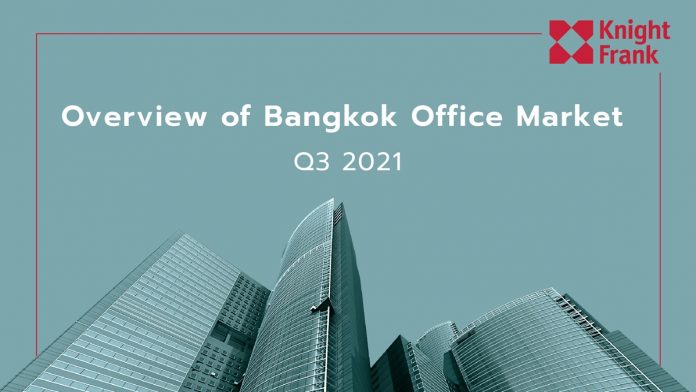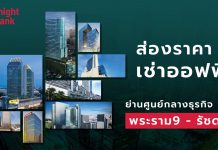
Mr. Marcus Burtenshaw, Executive Director and Head of Occupier Strategy and Solutions, Knight Frank Thailand, said, “As we head into the last quarter of 2021, Thailand seems to be emerging from under the shadow of the pandemic. More than 70% of Bangkok’s population has been fully vaccinated, and thankfully, the number of patients is dropping and recovery is steadily improving. November marks the date that Thailand will reopen its borders to vaccinated travellers, and for many firms, it will mark the return of their teams to the office. This presents an opportunity for tenants to review their space and assess whether it is still fit for purpose.
We would encourage tenants to ask yourselves and your real estate advisers the following questions; how well does your office accommodate hybrid working models? Does your office help your organisation to meet ESG related goals? How are you positioned to capitalise on anticipated market fluctuations?”
Economic Overview
The Bank of Thailand forecasted a 0.7% expansion for the Thai economy in 2021, a lower growth rate than the 3.0% estimate made in Q1. The economy will then pick up in the following year as it is projected to expand by 3.9% in 2022.
Although the economy was affected by COVID-19 containment measures and a slowdown in exports, the BOT highlighted significant progress on vaccination and earlier-than-expected relaxation of the containment measures as factors that would help restore private sector confidence and boost private consumption for the rest of 2021. In 2022, it is expected that the economy would gradually recover as domestic spending grows in parallel to improving confidence levels.
Nonetheless, the BOT cautions that the trajectory of the Thai economy will still be highly uncertain. Effective government measures and policy coordination among government agencies would be critical to support successful economic recovery.
The Business Sentiment Index (BSI) in September improved from the previous month due to improved business confidence for almost all business components following the easing of some lockdown restrictions. However, the overall BSI is still below the 50-threshold. The 3-month expected BSI improved to 50.7, thanks to Thailand’s reopening plan, which resulted in the non – manufacturing sector’s index reaching the 50-threshold for the first time in 6 months.
Respondents in the hotel and restaurant, the passenger transportation, and the retail sectors, responded with relatively high confidence to the reopening plan.

Supply
Total supply of office space in Bangkok remained at 5.53 million sq m in Q3 2021. No new buildings were added and no existing stock was withdrawn in this quarter.


Future Supply
Another 7 projects with a combined lettable area of around 160,300 sq m remains in the pipeline for this year. We anticipate that only 1 of these projects will be delayed to next year. Around 60% of the anticipated Q4 supply will be in the CBD.
If launches in Q4 2021 to 2026 do proceed as planned, the Bangkok office market supply will grow by 1.83 million sq m in total or approximately 350,000 sq m per year (excluding withdrawals). Developers remained unfazed by the market slowdown over the past year and may be encouraged by strong preleasing performances at some of the upcoming properties.

Demand
Following a promising Q2, leasing activity fell this quarter as take up dropped by 38% to 48,600 sq m. The 10-year average take up per quarter currently stands at 66,400 sq m. Meanwhile, 68,500 sq m of space was vacated, reversing 4 consecutive quarters of increase. This is still a significant improvement from the 113,000 sq m space vacated recorded in Q2 2020. Net absorption fell to -16,800 sq m as take up was below the amount of space vacated.
As net absorption was negative, total occupied space contracted by 0.4% Q-o-Q to 4.57 million sq m. More space that is partially or fully fitted out continued to be leased out as capital expenditure budgets for tenants remained limited. Although most of the fit out are existing builds left by vacating tenants, a few landlords have successfully attracted tenants via built-to-suit fit outs or tenant improvement allowances.
Several ongoing negotiations for profit-sharing agreements or management contract arrangements between flexible space operators and landlords are also underlying market movement.

The market occupancy rate fell to a new decade low of 82.7%, having dropped by 0.3% points. This is the 10th consecutive quarter in which the occupancy rate declined. The 10-year average occupancy rate now stands at 89.9%. Segmented by grade, the market occupancy rate increased for grade A and grade C properties, rising by 0.5% points and 2.0% points respectively. However, it fell for grade B, falling by 1.8% points.
Grade A properties remain the best performing properties with an occupancy rate of 90.4%. For the first time in over a decade, the market occupancy rate for grade B (80.4%) is below the rate for grade C (81.5%).
In addition to a marked increase in new supply classified as grade B over the past year, grade B properties were faced with stiff competition from grade A properties that have lowered their rents to more attractive rates and with the loss of tenants who cut costs by relocating to grade C buildings.
For the CBD, the occupancy rate dropped by 0.4% points Q-o-Q to 85.2%. The occupancy rate fell for most areas except for Ploenchit – Chidlom – Wireless and Thonglor – Ekkamai – Phra Khanong, which both experienced a 0.4% point increase.
Meanwhile, the occupancy rate for non-CBD areas dropped by 0.2% points to 79.4%. Despite this, both Paholyothin – Viphavadi and Bangna Srinakarin experienced some occupancy growth, with the occupancy rate increasing by 1.2% points and 0.4% points respectively.

Rental Rates
The average asking rent declined by 0.7% Q-o-Q to 786 baht per sq m per month. On an annual basis, the rate fell by 1.6%. In contrast, the average annual rental growth rate over the past decade stands at 3.6% per year. Most landlords continued to maintain their asking rents but provided greater room for negotiation. In some leasing deals, the effective rate is up to 30% lower than the asking rent.
In this quarter, we did observe a considerable shift in strategy for several grade A properties, which have discounted their asking rents to attract new tenants. This has been reflected by the 1.4% Q-o-Q drop in the grade A average asking rent. The average asking rent also declined for grades B and C, albeit to a lesser extent. It fell by 0.7% for grade B and just 0.1% for grade C.


The average asking rent fell by 0.9% Q-o-Q to 889 baht per sq m per month for CBD properties. Every sub-market experienced a quarterly decline in the average asking rent except for Silom – Sathorn – Rama IV, where the average remained at 850 baht. For non-CBD properties, the average rate dropped by 0.3% to 649 baht, but the results were mixed among sub-markets tracked.
While the asking rent declined for Petchburi – Rama IX – Ratchada and Bangna – Srinakarin, it increased by 1.2% in Paholyothin – Viphavadi.

Outlook
Despite signs of recovery witnessed in Q2, the market contracted once again in Q3 as the total occupied space, occupancy rate and asking rent all dropped on both a quarter and annual basis.
The COVID-19 pandemic continued to negatively impact both the Thai economy and the Bangkok office market as the daily number of people infected remained at around 10,000 throughout the quarter. With the upcoming November 1st opening of Thailand to fully vaccinated tourists without quarantine, achieving vaccination targets and controlling the spread of COVID-19 will be crucial to prevent further delays in economic recovery and will provide a much-needed boost for the office market as businesses resume operations to a greater extent.
Most companies that employed remote work continued to do so. We estimate that around 70% to 80% of employees in companies that require office space continued to work from home in Q3, in line with levels from the previous quarter.
Several companies have announced plans to return more employees back to the office by the end of this year but are still wary as COVID-19 infection rates remain high and it remains to be seen what impact the re-opening of the country will have.
It is evident that we are currently in a tenant’s market as the gap between supply and demand continued to widen. Companies that are looking to relocate over the upcoming year may find good value for money options with several high-quality properties offering attractive incentives, such as a rent-free period of up to 6 months.
Even if demand returns to pre-COVID levels, tenants will likely still have strong bargaining power given the relatively large supply pipeline, especially during the upcoming 3 years. We could potentially see a more balanced market emerge in 2025 if supply levels are adjusted and older, outdated properties are removed from the market at a substantial level.
Although we expect greater market competition to secure tenants over the next few years, we believe that market recovery will be K- shaped; Some properties will do exceptionally well while others falter. Even with the impact of COVID-19 and increase in supply levels, Grade A properties remained the top performers with an average occupancy rate of around 90%.
Meanwhile, the occupancy rate has slipped to 80% and 81% for grade B and C properties. So, although relocation activity has become even more cost-driven in the short term, there is still a strong preference for higher quality office space as part of mid to long-term strategies to support talent attraction and retention and business transformation initiatives. Even with hybrid work policies or space reduction, the office space remains an important component to organizations and employees.
In Q4, we anticipate strong openings for several new properties that have done an exceptionally well in the preleasing period. This signals that market movement is still ongoing and success even in a market downturn is achievable. It is now an optimal time for landlords of older properties to revisit their portfolio and consider some strategies that will enable them to safeguard their buildings from obsolescence.




















